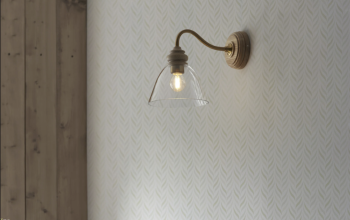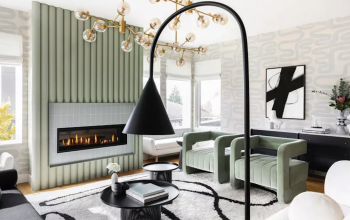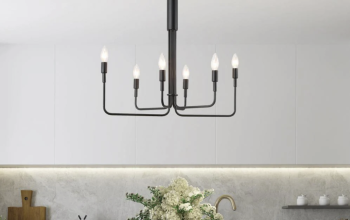When it comes to home decor, lighting plays a crucial role in creating the right ambiance and atmosphere. The right lighting can transform a space, making it feel warm and inviting or bright and energetic. One type of lighting fixture that is often overlooked but can have a significant impact on the overall look and feel of a room is the ceiling lamp. Thetoplamp
Ceiling lamps not only provide essential illumination but also serve as a statement piece in any room. They can add style, personality, and functionality to your space. Whether you’re looking to create a cozy reading nook, a sophisticated dining area, or a modern living room, choosing the right ceiling lamp is key.
Understanding Nordic Fashion: Key Elements and Characteristics
Nordic fashion has become increasingly popular in recent years, and its influence extends beyond clothing and accessories. Nordic design has made its mark on home decor as well, with its clean lines, simplicity, and functionality. Nordic fashion draws inspiration from nature and focuses on creating spaces that are minimalistic yet cozy.
One of the key elements of Nordic design is simplicity. Nordic fashion embraces clean lines and minimalistic aesthetics, creating spaces that are clutter-free and visually appealing. This simplicity allows for a sense of calm and tranquility in the home.
Another characteristic of Nordic design is functionality. Nordic fashion prioritizes practicality and usability without compromising on style. Furniture and decor pieces are designed with purpose in mind, ensuring that they serve their intended function while still adding beauty to the space.
Types of Ceiling Lamps: Which One is Right for Your Home?
When it comes to ceiling lamps, there are several types to choose from, each with its own unique style and functionality. The three most common types of ceiling lamps are pendant lamps, chandeliers, and flush mount lamps.
Pendant lamps are suspended from the ceiling by a cord or chain and hang down, creating a focal point in the room. They come in various shapes, sizes, and styles, making them versatile and suitable for different spaces. Pendant lamps are often used in dining areas, kitchens, and entryways.
Chandeliers are a more traditional and elegant option for ceiling lighting. They typically feature multiple arms or branches with light bulbs attached, creating a grand and luxurious look. Chandeliers are commonly used in formal dining rooms, foyers, and living rooms.
Flush mount lamps, also known as ceiling lights or overhead lights, are mounted directly against the ceiling without any hanging elements. They provide general illumination to the room and are often used in bedrooms, hallways, and bathrooms. Flush mount lamps are a practical choice for spaces with low ceilings or limited headroom.
When choosing the right type of ceiling lamp for your home, consider the style of your space, the purpose of the lighting, and your personal preferences. Each type of ceiling lamp has its own pros and cons, so it’s important to weigh them carefully before making a decision.
Materials and Finishes: Choosing the Perfect Look for Your Space
Ceiling lamps come in a variety of materials and finishes, each offering a different look and feel to your space. The choice of material and finish can greatly impact the overall style and aesthetic of your room.
Metal is a popular choice for ceiling lamps due to its durability and versatility. It can be finished in various ways, such as brushed nickel, polished chrome, or antique brass. Metal ceiling lamps can add a modern or industrial touch to your space.
Glass is another common material used in ceiling lamps. It can be clear or frosted, allowing for different levels of light diffusion. Glass ceiling lamps can create an elegant and sophisticated look in any room.
Wood is a more natural and rustic option for ceiling lamps. It adds warmth and texture to the space while still maintaining a clean and minimalistic aesthetic. Wood ceiling lamps are often used in Scandinavian or farmhouse-style interiors.
When choosing the perfect look for your space, consider the existing decor and style of your room. Opt for materials and finishes that complement the overall aesthetic and create a cohesive look.
Size and Proportions: How to Determine the Right Dimensions for Your Ceiling Lamp
Choosing the right size and proportions for your ceiling lamp is essential to ensure it fits well in your space and provides adequate illumination. The size of your room and the height of your ceiling are two key factors to consider when determining the dimensions of your ceiling lamp.
For pendant lamps, the general rule of thumb is to hang them at least 30 inches above a table or countertop to allow for sufficient headroom. The size of the pendant lamp should be proportionate to the size of the table or countertop. A good guideline is to choose a pendant lamp that is one-third to two-thirds the width of the table or countertop.
Chandeliers should also be proportionate to the size of the room and the height of the ceiling. In general, a chandelier should have a diameter that is one-half to two-thirds the width of the table or room it is illuminating. The height of the chandelier should be determined by the height of the ceiling. For ceilings that are 8 feet high, a chandelier should be hung around 30 inches above the table or floor.
Flush mount lamps should be chosen based on the size of the room and the desired level of illumination. In larger rooms, multiple flush mount lamps can be used to ensure even lighting throughout the space.
Light Bulbs and Wattage: Maximizing Illumination and Energy Efficiency

Choosing the right light bulbs and wattage for your ceiling lamp is crucial to maximize illumination and energy efficiency while still achieving the desired ambiance in your space. There are several factors to consider when selecting light bulbs for your ceiling lamp.
First, consider the color temperature of the light bulbs. Color temperature is measured in Kelvin (K) and determines the warmth or coolness of the light. For a cozy and warm ambiance, choose light bulbs with a lower color temperature, around 2700K to 3000K. For a brighter and more energetic atmosphere, opt for light bulbs with a higher color temperature, around 4000K to 5000K.
Second, consider the wattage of the light bulbs. The wattage determines the brightness of the light. Higher wattage bulbs produce more light, while lower wattage bulbs produce less light. It’s important to choose a wattage that provides adequate illumination for your space without being too harsh or overpowering.
Lastly, consider the energy efficiency of the light bulbs. LED bulbs are a popular choice for ceiling lamps due to their long lifespan and energy-saving capabilities. They consume less energy than traditional incandescent bulbs and produce less heat, making them a more sustainable and cost-effective option in the long run.
Installation and Maintenance: Tips for Properly Mounting and Caring for Your Ceiling Lamp
Proper installation and maintenance are essential to ensure your ceiling lamp stays in good condition for years to come. Here are some tips for mounting and caring for your ceiling lamp:
1. Follow the manufacturer’s instructions: Each ceiling lamp comes with specific installation instructions. It’s important to read and follow these instructions carefully to ensure proper installation and avoid any potential safety hazards.
2. Turn off the power: Before installing or replacing a ceiling lamp, always turn off the power at the circuit breaker to prevent electrical shock.
3. Use appropriate tools: Make sure you have the necessary tools on hand, such as a ladder, screwdriver, and wire cutter/stripper, to properly install your ceiling lamp.
4. Securely mount the lamp: Ensure that the ceiling lamp is securely mounted to the ceiling to prevent it from falling or becoming loose over time. Use appropriate hardware and follow the manufacturer’s instructions for mounting.
5. Clean regularly: Dust and dirt can accumulate on your ceiling lamp over time, affecting its appearance and performance. Regularly clean your ceiling lamp using a soft cloth or duster to remove any debris.
6. Check for loose connections: Periodically check the connections of your ceiling lamp to ensure they are secure and tight. Loose connections can cause flickering or dimming of the light.
7. Replace faulty parts: If any part of your ceiling lamp becomes damaged or faulty, such as a broken bulb or frayed wire, replace it immediately to prevent further damage or safety hazards.
By following these installation and maintenance tips, you can ensure that your ceiling lamp remains in good condition and provides optimal illumination for your space.
Styling and Placement: How to Incorporate Your Ceiling Lamp into Your Home Decor
Styling and placement are key factors in creating a cohesive and stylish look with your ceiling lamp. Here are some tips on how to incorporate your ceiling lamp into your home decor:
1. Consider the style of your space: Choose a ceiling lamp that complements the overall style of your room. For example, if you have a modern and minimalist space, opt for a sleek and simple pendant lamp. If you have a more traditional or vintage-inspired room, consider a chandelier with ornate details.
2. Create a focal point: Use your ceiling lamp as a focal point in the room by placing it in a prominent location, such as above a dining table or in the center of a living room. This will draw attention to the lamp and make it a statement piece in your space.
3. Layer lighting: Combine your ceiling lamp with other lighting fixtures, such as floor lamps or table lamps, to create layers of light in the room. This will add depth and dimension to your space while providing different levels of illumination for different activities.
4. Consider the height of the ceiling: The height of your ceiling will determine the placement of your ceiling lamp. For higher ceilings, consider using a longer cord or chain to hang your pendant lamp lower, creating a dramatic effect. For lower ceilings, opt for flush mount lamps or shorter pendant lamps to avoid any headroom issues.
5. Use multiple lamps: In larger rooms or open-concept spaces, consider using multiple ceiling lamps to ensure even lighting throughout the area. This can also create a visually balanced look and add interest to the space.
6. Coordinate with other decor elements: Choose a ceiling lamp that coordinates with other decor elements in the room, such as furniture, artwork, or accessories. This will create a cohesive and harmonious look in your space.
By considering these styling and placement tips, you can incorporate your ceiling lamp seamlessly into your home decor and create a stylish and inviting ambiance.
Budget and Value: Finding the Perfect Ceiling Lamp at the Right Price Point
Ceiling lamps come in a wide range of price points, making it possible to find the perfect one for your budget. When shopping for a ceiling lamp, it’s important to balance cost and value to ensure you get the most for your money.
Consider the quality of the materials and craftsmanship when evaluating the value of a ceiling lamp. Higher-quality materials and craftsmanship often result in a more durable and long-lasting product. While these may come at a higher price point initially, they can save you money in the long run by reducing the need for frequent replacements or repairs.
It’s also important to consider the functionality and features of the ceiling lamp when determining its value. Does it provide adequate illumination for your space? Does it have adjustable settings or dimming capabilities? These factors can greatly impact the overall value and usability of the lamp.
When shopping on a budget, consider alternative options such as thrift stores, online marketplaces, or DIY projects. You may be able to find unique and affordable ceiling lamps that fit your style and budget.
Ultimately, the value of a ceiling lamp is subjective and depends on your personal preferences, budget, and the overall aesthetic you’re trying to achieve in your space. By carefully evaluating the cost and value of different options, you can find the perfect ceiling lamp that meets your needs and enhances your home decor.
Elevating Your Home Decor with a Nordic-Inspired Ceiling Lamp
Ceiling lamps play a crucial role in home decor, providing essential illumination while also adding style and personality to a space. Nordic-inspired ceiling lamps, with their clean lines, simplicity, and functionality, are a popular choice for those looking to create a stylish and modern ambiance in their homes.
By understanding the key elements and characteristics of Nordic fashion, you can incorporate these principles into your home decor and choose the right ceiling lamp for your space. Consider the different types of ceiling lamps available, such as pendant lamps, chandeliers, and flush mount lamps, and select one that suits your style and purpose.
When choosing a ceiling lamp, consider the materials and finishes that will complement your existing decor. Pay attention to the size and proportions of the lamp to ensure it fits well in your space. Choose the right light bulbs and wattage to maximize illumination and energy efficiency.
Proper installation and maintenance are essential to ensure your ceiling lamp stays in good condition for years to come. Style and place your ceiling lamp strategically to create a cohesive look in your space. Consider your budget and the value of different options when making a purchasing decision.
By following these guidelines and incorporating a Nordic-inspired ceiling lamp into your home decor, you can elevate your space and create a stylish and functional ambiance that reflects your personal style.



